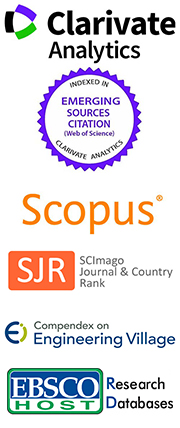Building Power Demand and Energy Consumption Forecasting Using a Data-Driven Model: a Case Study in a Student Hostel
Abstract
Keywords
Full Text:
PDFReferences
Tran L.N., Cai G., and Gao W., 2023. Determinants and approaches of household energy consumption: A review. Energy Reports 10: 1833-1850.
González-Torres M., Pérez-Lombard L., Coronel J.F., Maestre I.R., and Yan D., 2022. A review on buildings’ energy information: Trends, end-uses, fuels and drivers. Energy Reports 8:626-637.
Malaysia S.T., 2021. Malaysia Energy Statistics Handbook 2020. Energy Data and Research Unit, Putrajaya, Malaysia.
Shaikh P.H., Nor N.B.M., Sahito A.A., Nallagownden P., Elamvazuthi I., and Shaikh M., 2017. Building energy for sustainable development in Malaysia: A review. Renewable and Sustainable Energy Reviews 75: 1392-1403.
Universiti Teknikal Malaysia Melaka (UTeM)., 2024. National Energy Awards (NEA) 2024 Report. Category: Energy Management (Large Building). Centre For Smart Environment, UTeM, Melaka, Malaysia.
Pasini D., Reda F., and Häkkinen T., 2017. User engaging practices for energy saving in buildings: Critical review and new enhanced procedure. Energy and Buildings 148: 74-88.
Zhu J., Shen Y., Song Z., Zhou D., Zhang Z., and Kusiak A., 2019. Data-driven building load profiling and energy management. Sustainable Cities and Society 49: 101587.
Sepehr M., Eghtedaei R., Toolabimoghadam A., Noorollahi Y., and Mohammadi M., 2018. Modeling the electrical energy consumption profile for residential buildings in Iran. Sustainable Cities and Society 41: 481-489.
Wei S. and X. Bai. 2022. Multi-step short-term building energy consumption forecasting based on singular spectrum analysis and hybrid neural network. Energies 15(5): 1743.
Choi I.Y., Cho S.H., and Kim J.T., 2012. Energy consumption characteristics of high-rise apartment buildings according to building shape and mixed-use development. Energy and Buildings 46: 123-131.
Zhou Z., Zhang S., Wang C., Zuo J., He Q., and Rameezdeen R., 2016. Achieving energy efficient buildings via retrofitting of existing buildings: a case study. Journal of Cleaner Production 112: 3605-3615.
Khoshbakht M., Gou Z., and Dupre K., 2018. Energy use characteristics and benchmarking for higher education buildings. Energy and Buildings 164: 61-76.
Agdas D., Srinivasan R.S., Frost K., and Masters F.J., 2015. Energy use assessment of educational buildings: Toward a campus-wide sustainable energy policy. Sustainable Cities and Society 17: 15-21.
Do H. and K.S. Cetin. 2018. Residential building energy consumption: a review of energy data availability, characteristics, and energy performance prediction methods. Current Sustainable/Renewable Energy Reports 5: 76-85.
Amasyali K. and N.M. El-Gohary. 2018. A review of data-driven building energy consumption prediction studies. Renewable and Sustainable Energy Reviews 81: 1192-1205.
Runge J. and R. Zmeureanu. 2021. A review of deep learning techniques for forecasting energy use in buildings. Energies 14: 608, 2021.
Luo X. and L.O. Oyedele. 2021. Forecasting building energy consumption: Adaptive long-short term memory neural networks driven by genetic algorithm. Advanced Engineering Informatics 50: 101357.
Mariano-Hernández D., Hernández-Callejo L., García F.S., Duque-Perez O., and Zorita-Lamadrid A.L., 2020. A review of energy consumption forecasting in smart buildings: Methods, input variables, forecasting horizon and metrics. Applied Sciences 10(23): 8323.
Castillo J.N., Resabala V.F., Freire L.O., and Corrales B.P., 2022. Modeling and sensitivity analysis of the building energy consumption using the Monte Carlo method. Energy Reports 8: 518-524.
Ghenai C., Al-Mufti O.A.A., Al-Isawi O.A.M., Amirah L.H.L., and Merabet A., 2022. Short-term building electrical load forecasting using adaptive neuro-fuzzy inference system (ANFIS). Journal of Building Engineering 52: 104323.
Tsala S., Koronaki I., and Orfanos G., 2024. Utilizing weather forecast meteorological models for building energy simulations: A case study of a multi-unit residential complex. Energy and Buildings 305: 113848.
Energy Dashboard UTeM. 2024. Tenaga Elektrik > Analisa Perbandingan [Online serial], Retrieved March 21, 2024 from the Web: https://portal.utem.edu.my/iDBD/home/
Fan C., Xiao F., and Wang S., 2014. Development of prediction models for next-day building energy consumption and peak power demand using data mining techniques. Applied Energy 127:1-10.
Moreno J.J.M., Pol A.P., Abad A.S., and Blasco, B.C., 2013. Using the R-MAPE index as a resistant measure of forecast accuracy. Psicothema 25(4): 500-506.
ASHRAE. 2014. ASHRAE Guideline 14-2014: Measurement of Energy, Demand, and Water Savings. American Society of Heating, Refrigerating and Air-Conditioning Engineers, Atlanta, GA.
DOI: https://doi.org/10.64289/iej.25.0103.6388757


